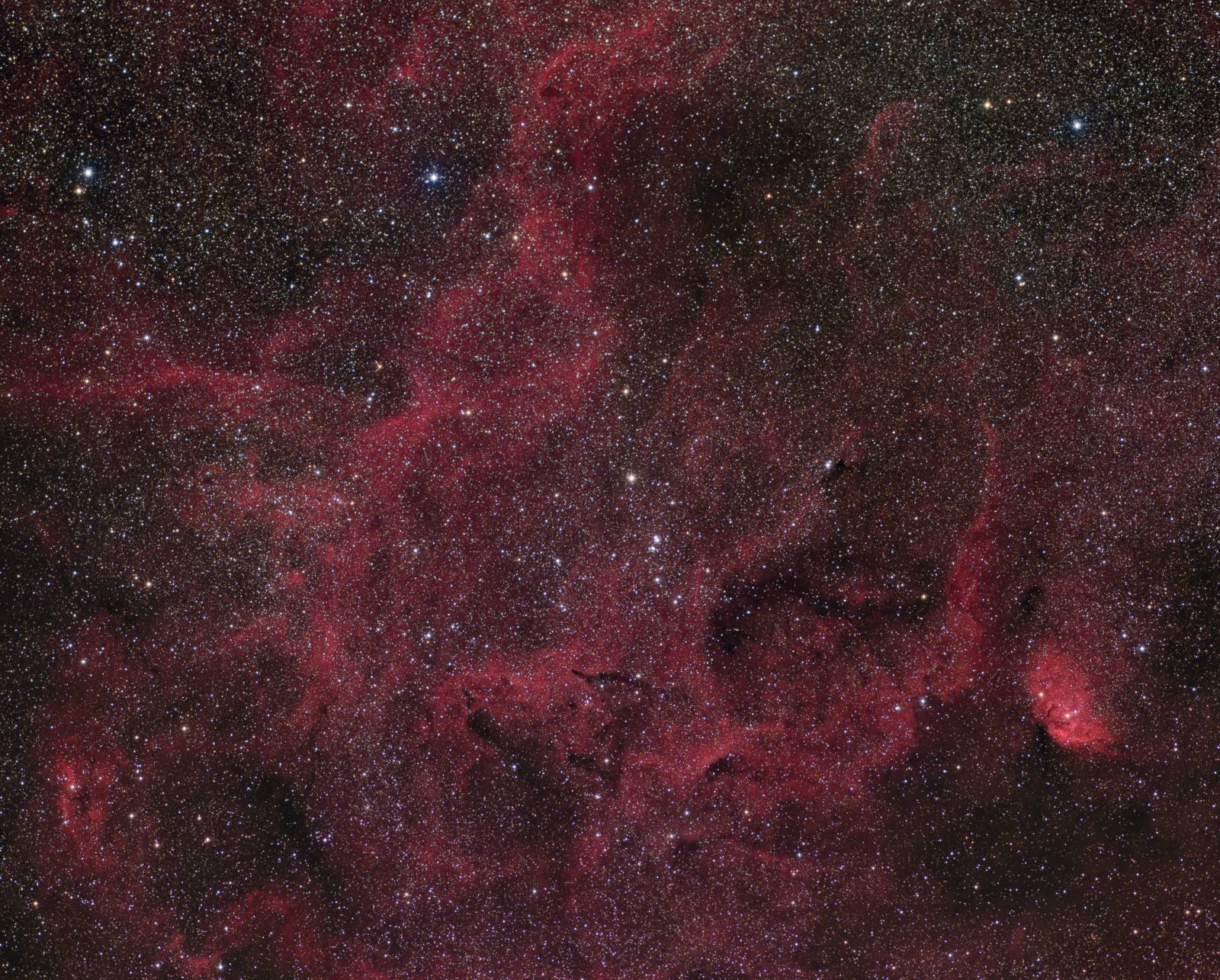Tulip Nebula Region – Wide Field
 Click image for full size version
Click image for full size version
September 18, 2017
This wide field image shows a the region adjacent to the Tulip Nebula, which is the bright patch at lower right in this image. I actually started out on this project with the Tulip in the centre, but noticed this lovely lacy nebulosity nearby. Some of the many other deep sky objects in this image are shown in an annotated version.
This image includes the location of one of the first suspected black holes, called Cygnus X-1. It forms a binary pair with a blue supergiant variable star (a big, hot star that changes brightness periodically). To find it, first locate the vertical pair of moderately bright stars near the right edge of the image, level with the bottom of part of Sh2-101. The lower (and brighter) of these two stars is the blue supergiant. The black hole is, of course, not visible.
Tekkies:
Moravian G3-16200 EC camera (on loan from O’Telescope), Optolong Ha, R, G and B filters, Takahashi FSQ-106 ED IV at f/3.6, Paramount MX, unguided. Acquisition with the SkyX, focused with FocusMax, scripted with CCD Commander. All pre-processing and processing in PixInsight. Acquired from my SkyShed in Guelph. Moderate moonlight for Ha, no moonlight for RGB, average transparency and seeing.
16x5m R, G, B and 77x10m Ha unbinned frames (total=16hr30m).
NB-RGB Creation:
Creation and cleanup: The BatchPreProcessing script was used to perform calibration, cosmetic correction and registration of all frames. LocalNormalization, ImageIntegration and DrizzleIntegration were used to make the Ha, R, G and B masters. The masters were cropped to remove edge artifacts. R, G and B were combined to make an RGB image which was processed with DBE, BackgroundNeutralization and ColorCalibration.
Combining Ha and RGB data: The NBRGBCombination script was run with default settings using Ha for red narrowband. PhotometricColorCalibration was applied.
Linear Noise Reduction: MultiscaleLinearTransform was used to reduce noise in the NB-RGB image. Layer settings for threshold and strength: Layer 1: 3.0 0.8 Layer 2: 2.5, 0.7 Layer 3: 2., 0.6 Layer 4: 1.0, 0.2 Layer 5: 0.5, 0.1.
Stretching: HistogramTransformation was applied to the NB-RGB image to make a pleasing, bright image.
Synthetic Luminance:
Creation and cleanup of SynthL: The four channel masters were processed with DBE and then integrated (average, noise weighted, no rejection) using ImageIntegration to create the SynthL.
Deconvolution: A star mask was made to use as a local deringing support image. A copy of the image was stretched to use as a range mask. Deconvolution was applied (50 iterations, regularized Richardson-Lucy, external PSF made using DynamicPSF tool with about 30 stars).
Linear Noise Reduction: MultiscaleLinearTransform was used to reduce noise in the background areas of the NB-RGB file. Layer settings for threshold and strength: Layer 1: 3.0 0.8 Layer 2: 2.5, 0.6 Layer 3: 2., 0.5 Layer 4: 1.0, 0.2.
Stretching: HistogramTransformation was applied to the SynthL to make a pleasing, bright image.
Dynamic Range Adjustment: HDRMultiscaleTransform was applied at scales of 6 and 4 pixels using a mask to protect stars and background.
Noise Reduction and Re-Stretch: TGVDenoise was applied in Lab mode with 300 iterations with a range mask applied to protect high signal areas. This was followed by a HistogramTransformation to raise the black point (but with no clipping).
Local Contrast Adjustment: Areas of the image that had been processed with HDRMultiscaleTransform were processed with two passes of LocalHistrogramEqualization with max contrast of 1.5 (scale 50, strength 0.45 and scale 150, strength 0.18) using a mask to protect background and stars.
Combining SynthL with NB-RGB:
The processed SynthL was applied to the NB-RGB image using LRGBCombine.
Additional Processing:
Final Steps: MultiscaleLinearTransform was used to sharpen the structures in the bright parts of the nebulae (layers 2-4 at 0.035). The StarReduction script was applied to a copy of the image which was then blended back with the original 1:2 using a star mask to limit the tool’s effect to small and medium sized stars. The DarkStructureEnhance script was used to increase contrast between dark nebula and brighter regions. Background, nebula and star brightness, contrast and saturation were adjusted in several iterations using Curves with masks as required. A range mask was used to protect background and stars while adjusting the hue of the nebula to reduce a slight orange cast. The image was reduced in size by a factor of 2 with IntegerResample to restore resolution to its original value.
Image scale is about 3.2 arcsec per pixel for this camera/telescope combination.






Leave A Comment